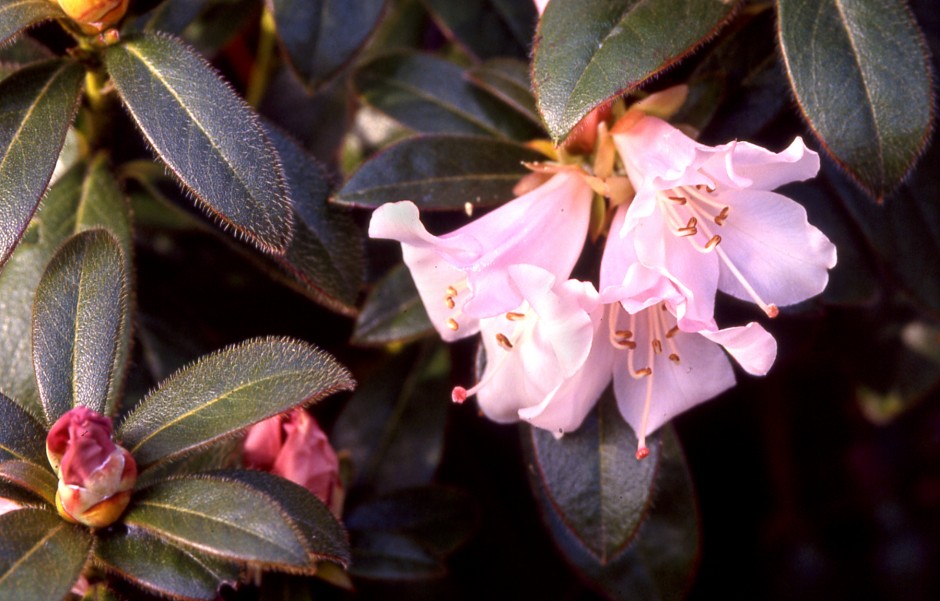
Of the many outstanding introductions of Rhododendron species made by Joseph Dalton Hooker during his famous expedition to Sikkim and surrounding regions in 1848-1949, Rhododendron ciliatum is perhaps one of the least widely grown “hardy” species in the modern garden. This is unfortunate given that the semi-dwarf habit, attractive foliage, and large funnel-shaped flowers provide more than enough reason to cultivate this early spring bloomer in the modern, often smaller garden.
As previously mentioned, Rhododendron ciliatum was first introduced into western cultivation and science from the Sikkim Himalaya. It was subsequently collected from the mountains of adjacent eastern Nepal, Bhutan, and southern Tibet. It is found from 8,000 to 13,000 feet in elevation growing in various habitats including coniferous forests, rhododendron thickets, and open rocky slopes. One interesting habitat for this species that I was able to observe first hand during a 1997 expedition to Sikkim was the occurrence of large colonies on open slopes in what amounted to running water. The plants were generally “perched” upon low hummocks of turf in the wet seeping meadows, but were nonetheless growing in seemingly saturated soil conditions. I must say that if I were to try such a thing in the garden, it would undoubtedly result in a complete failure. These wild rhododendrons were quite happy in their soggy situation, however. In stark contrast, I observed this species in another region growing on dry exposed grassy slopes under conditions quite at odds with what one would consider to be good Rhododendron habitat, yet these plants also appeared to be quite healthy.
Rhododendron ciliatum is one of the few hardy (relatively speaking, of course) members of Subsection Maddenia, a large group that is considered to be quite tender in most rhododendron growing regions. In fact, this species and the yellow-flowered R. fletcherianum are the only species within the subsection that can be considered reliably hardy in most of the Pacific Northwest. Fairly isolated from related species throughout most of its range, Rhododendron ciliatum is one of the few taxonomically “solid” members of the Ciliicalyx/Johnstoneanum Alliance. Under the former Balfourian system of taxonomy, H.H. Davidian included this and several closely related species in the “Ciliatum Series,” distinct from, but with ties to, the “Maddenii Series.”
This species forms a neat, mounding, and compact shrub, slowly reaching around three or four feet in height and as wide in cultivation. Like many members of Subsection Maddenia, it is blessed with the bonus ornamentation of attractive peeling, smooth, and reddish-brown bark. The deep green evergreen foliage is elliptic in shape and generally around two or three inches in length. The leaves are bordered with a conspicuous fringe of hairs, called “ciliate.” The flowers (early to mid-spring) appear as bell-shaped funnels in clusters of two to five. They are white to white flushed pink or pink and up to two inches in length. Unfortunately, the flowers are not fragrant, but their size and color in comparison with the plant habit and foliage makes for an outstanding display. This species underplanted beneath and around the taller, yellow-flowered R. lutescens provides a fine display in the early part of the flowering season.
In cultivation, R. ciliatum is relatively trouble-free if provided with good drainage and supplemental irrigation during long dry periods, as with all rhododendrons. It performs best in a bright, fairly sunny position where it will form a dense, compact mound but is tolerant of shade where it will become a bit leggy and open. Of course, you then have the advantage of enjoying the attractive bark. It is hardy to around +5° F. but you may want to position the plant where it will have some protection from late spring frosts if your garden in an area prone to such events. A location, such as within a light woodland or under high conifers, will provide some protection for the relatively early flowers.
This species has been used quite often in hybridizing and is the parent of many widely grown and well-known hybrids. A short list of these would include ‘Countess of Haddington,’ ‘Praecox,’ and ‘Cilpinense,’ a cross with R. moupinense which is often mislabeled and sold as R. moupinense in the trade.
A form of this species with white tinged pink flowers won an Award of Merit when exhibited by Lord Digby of Minterne in 1953.
1965/352 Brodick. White flowers.
1966/665 Wood. White flushed pink flowers.
1980/077 LS&H#16019:Castle Howard. White flushed pink flowers. Collected wild in Bhutan.
1982/172 Hed#378:Hedegaard. White slightly flushed rose flowers. Collected wild at 11,500 feet in Nepal.
1995/072 BLM#324:Glendoick. Collected wild in eastern Nepal.
1999/102 Gerdemann. Jim’s “best pink” which I have not seen in flower yet.
2000 #s /064/069/082/094/111 SEH#545 From my collection of seed in the eastern Himalaya.
REFERENCES CONSULTED:
Cox, Peter A., Kenneth N.E Cox. 1997. The Encyclopedia of Rhododendron Species. Perth, Scotland: Glendoick Press. pgs. 296-297.
Davidian, H.H. 1982. The Rhododendron Species. Vol. I. Portland, OR: Timber Press. Pgs. 100-102.
Hootman, S.E. 1997. Unpublished field notes.
Rhododendron Species Foundation: Records – 1964 to present.
Steve Hootman
